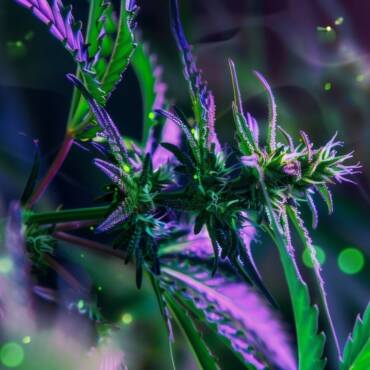Hemp for Pets, Oh My!
Our pets mean the world to us, they fill our lives with happiness and laughter, they are loyal and never judge us, they forgive us and are always happy to see us. We love our pets. We want them to be happy and healthy and it’s awful when they are sick. It hurts us to see our pets suffering.
Cannabis has been used for thousands of years for it’s therapeutic qualities and as it becomes more and more accepted today for it’s medicinal benefits people are realizing that cannabis works wonders not only for humans but for our four legged friends as well.
You got it. Medical marijuana for pets!
Some people may call the cannabis movement a trend or a craze, but this herb’s therapeutic properties are science-based fact.
Oakland-based veterinarian Dr. Gary Richter tells us cannabis can be used on your pet to treat a variety of medical conditions including:
- Allergies/ itching
- Anxiety
- Arthritis and other causes of pain
- Appetite support
- Cancer treatment
- Cancer pain
- Glaucoma
- Inflammatory Bowel Disease
- Quality of life / Hospice care
- Seizures
But, we still have a lot to learn about cannabis in general and marijuana for pets is no different.
If you’re considering medical marijuana for pets, here are some important points you want to keep in mind.
And of course, be sure to consult with a trusted veterinarian before giving medical marijuana to your pet.
Pets have endocannabinoid systems, just like us humans
The endocannabinoid system is quickly gaining relevance in modern medicine for both humans and pets.
Just like humans, animals also have endocannabinoid systems (ECS).
The ECS has receptors throughout the whole body. It is this system that helps us maintain balance in our body. If we are deficient in cannabinoids our body is out of whack so to speak. We are unbalanced.
Like us, animals produce their own cannabinoids to interact with and signal the ECS. And like us, animals also run into endocannabinoid deficiencies. This is where whole-plant-based cannabis medicine comes into play. Cannabis has cannabinoids which attach to our ECS and create balance and healing for those deficient in cannabinoids. It is almost as if this plant was created specifically to heal and balance our bodies.
Be very careful with dosing marijuana to your pet.
A marijuana overdose is not fatal, but it can be a traumatic experience as a pet owner.
The general rule of thumb is this: give the smallest dose possible and gradually work your way up until you find the smallest yet most effective cannabis dosage level for your pet.
But knowing exactly what dosage you’re giving your pet can be tricky, Richter says.
And because many of the products on the market are highly potent and animals have a smaller body size, we have to be extra careful.
Signs of a pet marijuana overdose.
If your pet does experience a cannabis overdose, don’t let the mishap turn you away from this medicine completely. The therapeutic potential is still there if done properly.
Too much THC can be extremely unpleasant, and with pets it’s really easy to overdo it if you’re not careful – or if you don’t know what you’re doing.
So what does a pet overdose look like, and how do you know when to make a trip to the emergency clinic?
“A lot of it might be what you expect. The animal will start to look a little bit spacey and get a bit wobbly,” Richter says. “A lot of dogs will develop the syndrome called static ataxia, where basically they’re standing still and start to tip over but catch themselves before they fall.”
If the overdose is substantial enough, the pet’s blood pressure level may not be particularly stable or they won’t eat, Richter says.
Even though these overdoses are not fatal they can be an extremely traumatic – not to mention pricey – experience for pets and families.
Nobody wants to see their pet in that kind of condition. And the thing with edibles is that the effects can be really long-lasting, 12 hours or longer depending on how much has been consumed.
It’s an experience that can turn pet owners away from marijuana for pets completely, even though there is still therapeutic potential if done properly. New research is showing that CBD can counteract the affects of a THC overdose, kind of an antidote.
Should you take your pet to the emergency clinic?
“If the dog is a little wobbly but seems comfortable, I would not necessarily advise a visit to the emergency room. If you are concerned however, it’s best to contact a veterinarian for advice,” Richter says.
“If the pet is having a hard time standing and they’re not really responding properly and they’re not eating or drinking, then they probably need to be seen for that.”
Learn the methods of marijuana delivery for your pet.
Deciding which delivery method is best for your pet can take some research.
Capsules, treats, tinctures, topicals – just like cannabis medicine for humans, we have a variety of options in delivering marijuana for pets.
Richter has seen a lot of pet owners find success with cannabis oils, which they give their pet orally.
He has also seen a cannabis topical spray clear up severe skin allergies in dogs, to the point where they stop scratching for 4 to 6 hours.
“Short of loading them up on a steroid like prednisone, nothing does that. This topical is nothing short of amazing,” Richter says.
Yet another method of delivery, although Richter has yet to see it applied to pets, is a cannabis suppository.
Figuring out THC-CBD ratios for pets.
With cannabis there are countless options to form the ultimate combination of strains, cannabinoids, and terpenes.
This is an important part of cannabis medicine, especially because the amount of THC, CBD, and other cannabinoids, flavonoids, and terpenes can fluctuate wildly from one strain to another.
Dr. Richter has seen success with varying ratios of THC and CBD depending on the condition being treated. “Sometimes, higher concentrations of THC are more effective provided the product is dosed correctly,” he says.
Finding the best ratio of marijuana for pets requires experimenting, trial and error – and of course safe access to products that are accurately and precisely labeled.
“It is always best to seek the advice of an experienced veterinary professional when deciding which product and what dose to use,” Richter says.
Richter advises against CBD products where there is little to no THC – such as with a lot of the CBD hemp oils found online.
“If you’re looking to treat a dog that maybe has minor soreness, there might be some positive effect with a hemp-based CBD product, but otherwise you’re severely restricting your therapeutic applications,” he says.
“With higher-end therapy for things like cancer, autoimmune disease, seizures, or even severe pain, you want a product that is made from cannabis – not hemp – that has a certain amount of THC in it.”
The difference without THC in the mix, Richter says, is like the difference between shooting a bullet and throwing it.
Talk to your veterinarian about marijuana for pets.
Whether you live in a prohibition state or not, it’s okay to talk to your vet about marijuana for pets.
The conversation has to start somewhere, and even if your veterinarian knows next to nothing about cannabis – that’ll change if enough people start asking.
“As cannabis becomes more available, you’re going to see people out there who will want to use it with their pets,” Richter says. “It’s going to be really important that somebody is able to provide people with guidance. There’s an opportunity here for education.”
Help spread cannabis education by sharing this article with friends and followers. Who knows how many pets we might save.
ABOUT
Dr. Gary Richter is the owner and medical director of two award-winning veterinary hospitals in Oakland, California. His facilities, Montclair Veterinary Hospital and Holistic Veterinary Care provide both Western and complementary medicine for patients.
Dr. Richter approaches veterinary medicine with an “eyes open” strategy. He utilizes Western medicine, complementary and alternative care, and new, emerging therapies to achieve the best possible results. By incorporating modalities such as herbal/nutritional therapy, acupuncture, chiropractic, and hyperbaric oxygen with conventional medicine and surgery, Dr. Richter does more than treat disease – he promotes healing and wellness.
“There are many conditions that can only be treated with Western medicine and surgery,” says Dr. Richter. “But clearly Western medicine is not the solution to every problem. It would be a mistake for us to turn our backs on successful treatment options because they are not mainstream or widely accepted. There are many occasions when alternative therapy or a combination of therapies is the best solution. If optimal health and welfare is the goal, every legitimate option should be considered for every patient.”
Article by Green Flower Media – Gregory Frye
If you are interested in using marijuana for pets, We Recommend…
At FlowerChild CBD we recommend our CBD Tincture for Pets. This tincture has been specially formulated for animals with a very high CBD to THC ratio 25:1. It is a medicinal cannabis CBD not a industrial hemp CBD! see What is the Difference between industrial and medicinal hemp CBD?
THC is what gets you high. CBD does not. THC is necessary in the blend to work synergistically with the CBD, but huge amounts of THC are not necessary to receive the medical benefits of the cannabis.






